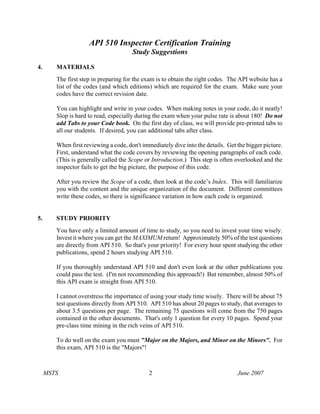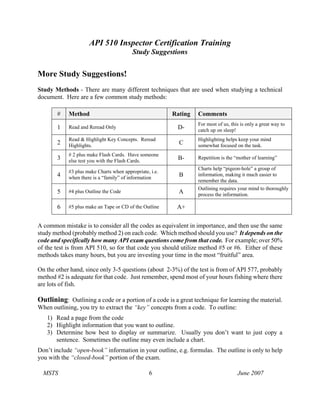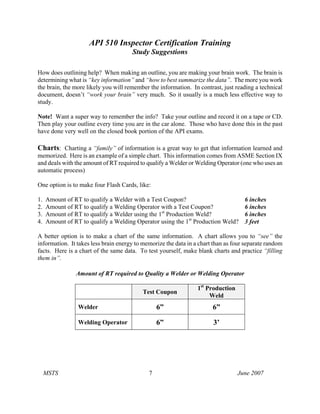Api 510 study plan
- 1. API 510 Inspector Certification Training Study Suggestions MSTS 1 June 2007 Welcome to API 510 Training!! Youre making a significant investment in your career. Here a few study suggestions. 1. APIS APPLICATION An API application can be downloaded from APIs ICP website at www.api.org/icp. The application must be returned to API about 2 months prior to of the exam. 2. THE BODY OF KNOWLEDGE The Body of Knowledge is another document that can be downloaded from APIs website. It details what is covered by the exam. It's rather lengthy and initially overwhelming. It's a big elephant! But dont fret, you will "eat this elephant one bite at a time!" 3. THE EXAMINATION The exam always has a total of 150 multiple-choice questions. Each question has four possible answers and there is only one right answer. You will record your answers on a bubble-sheet using your #2 lead pencil. The exam is divided into two 4-hour sessions. During the morning session, the open-book portion of the exam is given. It usually has about 45-55 questions. Most inspectors spend 3-4 hours completing this portion of the exam. The open-book questions generally focus on calculations and looking up detailed information from Tables or Code Paragraphs. After lunch, the closed-book session is given and it usually has about 95-105 questions. Most inspectors spend 1-1/2 to 2 hours completing this portion of the exam. We suggest you also download a Training Aid called Test Taking Tips from the MSTS website. This aid provides useful advice and has a list of items to bring to the exam. FYI  How are the API exams developed? Periodically a question writing session is conducted. Subject Matter Experts (SMEs), persons who know pressure vessels, write questions from specific sections of the Code. Each question is then checked by three other SMEs. This validation exercise checks two items; first, is the question written clearly, and second, does the question cover knowledge that is important to a vessel inspector. These questions then go into a question data-bank. Presently there are over 1000 questions in the data-bank and are grouped by topics. For each examination, 150 questions are randomly selected from the data-bank by topic.
- 2. API 510 Inspector Certification Training Study Suggestions MSTS 2 June 2007 4. MATERIALS The first step in preparing for the exam is to obtain the right codes. The API website has a list of the codes (and which editions) which are required for the exam. Make sure your codes have the correct revision date. You can highlight and write in your codes. When making notes in your code, do it neatly! Slop is hard to read, especially during the exam when your pulse rate is about 180! Do not add Tabs to your Code book. On the first day of class, we will provide pre-printed tabs to all our students. If desired, you can additional tabs after class. When first reviewing a code, don't immediately dive into the details. Get the bigger picture. First, understand what the code covers by reviewing the opening paragraphs of each code. (This is generally called the Scope or Introduction.) This step is often overlooked and the inspector fails to get the big picture, the purpose of this code. After you review the Scope of a code, then look at the codeÔÇÖs Index. This will familiarize you with the content and the unique organization of the document. Different committees write these codes, so there is significance variation in how each code is organized. 5. STUDY PRIORITY You have only a limited amount of time to study, so you need to invest your time wisely. Invest it where you can get the MAXIMUM return! Approximately 50% of the test questions are directly from API 510. So that's your priority! For every hour spent studying the other publications, spend 2 hours studying API 510. If you thoroughly understand API 510 and don't even look at the other publications you could pass the test. (I'm not recommending this approach!) But remember, almost 50% of this API exam is straight from API 510. I cannot overstress the importance of using your study time wisely. There will be about 75 test questions directly from API 510. API 510 has about 20 pages to study, that averages to about 3.5 questions per page. The remaining 75 questions will come from the 750 pages contained in the other documents. That's only 1 question for every 10 pages. Spend your pre-class time mining in the rich veins of API 510. To do well on the exam you must "Major on the Majors, and Minor on the Minors". For this exam, API 510 is the "Majors"!
- 3. API 510 Inspector Certification Training Study Suggestions MSTS 3 June 2007 6. STUDY SUGGESTIONS So how do we "eat this elephant"? Start with API 510 and then spell "SUCCESS". If you use "SUCCESS" you will be SUCCESSful. I guarantee it! Here's what "SUCCESS" represents. S - SECTION by section. Don't jump around in API 510. Start with Section 1 and thoroughly study it before moving on to the next section. A suggested study plan provided a few pages later has a proposed order for studying the sections of API 510. U - UNDERLINE or highlight key ideas or words. Highlighting helps our memorization and also makes it easier for us to find key information as we review. (Note! Don't highlight every line or it loses its emphasis.) C - CHART when possible. Draw your own charts or tables when it will help you summarize a lot of information. It is easier to memorize a ÔÇ£family of informationÔÇØ by using a chart vs. a series of flashcards. C - CLARIFY issues. Always try to understand the reasoning behind the statements in the Code. If you understand the concepts then the information makes more sense. If you donÔÇÖt understand the issue, jot a question and make sure you get it answered in class. E - EXAMINATION by others. Have others ask you questions, questions, and more questions. Questions should come from your highlighted key concepts. This step will be one of the most significant keys to your success. S - SEEK assistance when stumped. Don't waste valuable time researching answers when confused. Get on the phone, get the quick answer, then push on! Remember time is limited. S - STAY on track. Be methodical and organized in your study. Don't overdo some sections only to rush through the last sections. Other Good Ideas: Many inspectors make Flash Cards of key ideas using 3ÔÇØ x 5ÔÇØ index cards. Another idea is to Outline sections in API 510. This tremendously helps you memorize the key facts.
- 4. API 510 Inspector Certification Training Study Suggestions MSTS 4 June 2007 ASME PUBLICATIONS - We will cover the ASME Codes very thoroughly in class. We suggest that you don't study these Codes prior to the class. Perhaps just look at the introduction sections so see what they cover. OTHER API PUBLICATIONS STUDYING INSTRUCTIONS - Read and highlight the other API publications. Later review the underlined sections a couple of times. Once again have others ask you questions. Note! Check APIÔÇÖs Body of Knowledge. Not all paragraphs in API 571 are covered on the exam. 7. TIME COMMITMENT Time is your limited resource. If you follow the above suggestions your learning efficiency will increase. Why spend 100 hours studying haphazardly when you could learn just as much or even more in 50 hours with a disciplined and organized approach. Attached is preparation plan with an organized approach for your study time. The plan is based on 6 weeks of preparation with a minimum of 6-8 study hours each week. This plan will allow you to study at a scheduled pace. Your learning and satisfaction will significantly increase with this disciplined approach. Do not wait and cram the week prior to the test. You may be able to pass the test, but you will soon forget what little you learned. Preparing for a certification exams is a great opportunity to really increase your inspection knowledge and skills. Make the most of it.
- 5. API 510 Inspector Certification Training Study Suggestions MSTS 5 June 2007 WEEK 1 ____ API 510 - Read, highlight and outline API 510 (7 hr) ____ API 510 - Create API 510 flashcards (1 hr) WEEK 2 ____ API 572 - Complete Study Guide Note! Posted on MSTS website (4 hr) ____ API 572 - Create API 572 flashcards (1 hr) ____ Training Aid - The Inspectors Calcs (Part 1 & 2) Note! Posted on MSTS website (2 hr) ____ API 510 - Review highlights & flashcards (1 hr) WEEK 3 ____ API 576 - Read and highlight API 576 (2 hr) ____ API 576 - Create API 576 flashcards (1 hr) ____ Training Aid - The Inspectors Calcs Quiz Note! Posted on MSTS website (2 hr) ____ API 510 - Reread API 510, study highlights (1 hr) ____ Review all flashcards (1 hr) WEEK 4 ____ API 571 - Read and highlight API 571 (only appropriate sections) (2 hr) ____ API 571 - Create API 571 flashcards (1 hr) ____ API 572 - Redo Study Questions Note! Posted on MSTS website (2 hr) ____ API 510 - Reread API 510, study highlights (1 hr) ____ Review all flashcards (1 hr) WEEK 5 ____ API 577 - Read and highlight API 577 (3 hr) ____ API 577 - Create API 577 flashcards (1 hr) ____ API 576 - Reread API 576, study highlights (2 hr) ____ API 510 - Reread API 510, study highlights (1 hr) ____ Review all flashcards (1 hr) WEEK 6  Class Time ____ Come to class & study hard (70+ hr) ____ Learn each required calculation ____ Learn how to find answers in the big books ____ Highlight and tab key areas ____ Ask questions, dont leave class confused about concepts AFTER CLASS ____ Develop Study Plan (allocate time and content) (1 hr) ____ Do the Plan - Refresh what you know, and clarify what you dont know then PASS the EXAM If you get stumped please give me a call, page or E-mail. My goal is to help you to achieve your potential!
- 6. API 510 Inspector Certification Training Study Suggestions MSTS 6 June 2007 More Study Suggestions! Study Methods - There are many different techniques that are used when studying a technical document. Here are a few common study methods: # Method Rating Comments 1 Read and Reread Only D- For most of us, this is only a great way to catch up on sleep! 2 Read & Highlight Key Concepts. Reread Highlights. C Highlighting helps keep your mind somewhat focused on the task. 3 # 2 plus make Flash Cards. Have someone else test you with the Flash Cards. B- Repetition is the ÔÇ£mother of learningÔÇØ 4 #3 plus make Charts when appropriate, i.e. when there is a ÔÇ£familyÔÇØ of information B Charts help ÔÇ£pigeon-holeÔÇØ a group of information, making it much easier to remember the data. 5 #4 plus Outline the Code A Outlining requires your mind to thoroughly process the information. 6 #5 plus make an Tape or CD of the Outline A+ A common mistake is to consider all the codes as equivalent in importance, and then use the same study method (probably method 2) on each code. Which method should you use? It depends on the code and specifically how many API exam questions come from that code. For example; over 50% of the test is from API 510, so for that code you should utilize method #5 or #6. Either of these methods takes many hours, but you are investing your time in the most ÔÇ£fruitfulÔÇØ area. On the other hand, since only 3-5 questions (about 2-3%) of the test is from of API 577, probably method #2 is adequate for that code. Just remember, spend most of your hours fishing where there are lots of fish. Outlining: Outlining a code or a portion of a code is a great technique for learning the material. When outlining, you try to extract the ÔÇ£keyÔÇØ concepts from a code. To outline: 1) Read a page from the code 2) Highlight information that you want to outline. 3) Determine how best to display or summarize. Usually you donÔÇÖt want to just copy a sentence. Sometimes the outline may even include a chart. DonÔÇÖt include ÔÇ£open-bookÔÇØ information in your outline, e.g. formulas. The outline is only to help you with the ÔÇ£closed-bookÔÇØ portion of the exam.
- 7. API 510 Inspector Certification Training Study Suggestions MSTS 7 June 2007 How does outlining help? When making an outline, you are making your brain work. The brain is determining what is ÔÇ£key informationÔÇØ and ÔÇ£how to best summarize the dataÔÇØ. The more you work the brain, the more likely you will remember the information. In contrast, just reading a technical document, doesnÔÇÖt ÔÇ£work your brainÔÇØ very much. So it usually is a much less effective way to study. Note! Want a super way to remember the info? Take your outline and record it on a tape or CD. Then play your outline every time you are in the car alone. Those who have done this in the past have done very well on the closed book portion of the API exams. Charts: Charting a ÔÇ£familyÔÇØ of information is a great way to get that information learned and memorized. Here is an example of a simple chart. This information comes from ASME Section IX and deals with the amount of RT required to qualify a Welder or Welding Operator (one who uses an automatic process) One option is to make four Flash Cards, like: 1. Amount of RT to qualify a Welder with a Test Coupon? 6 inches 2. Amount of RT to qualify a Welding Operator with a Test Coupon? 6 inches 3. Amount of RT to qualify a Welder using the 1st Production Weld? 6 inches 4. Amount of RT to qualify a Welding Operator using the 1st Production Weld? 3 feet A better option is to make a chart of the same information. A chart allows you to ÔÇ£seeÔÇØ the information. It takes less brain energy to memorize the data in a chart than as four separate random facts. Here is a chart of the same data. To test yourself, make blank charts and practice ÔÇ£filling them inÔÇØ. Amount of RT required to Quality a Welder or Welding Operator Test Coupon 1st Production Weld Welder 6ÔÇØ 6ÔÇØ Welding Operator 6ÔÇØ 3ÔÇÖ







